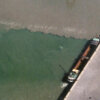“Facts About Turbidity & Dredging” describes the characteristics of turbidity and the importance of measuring and monitoring turbidity during dredging.
Turbidity is an optical quality of water and describes how clear or transparent water is. Water that contains particles which cause cloudiness or muddiness is called turbid. If it is too cloudy or opaque it can result in the disturbance or blockage of sunlight, which can impact marine flora and fauna.
Turbidity is a natural phenomenon that occurs in all bodies of water – oceans, lakes or rivers and is in itself not a pollutant. Although storms, waves and heavy currents can cause increased turbidity, which can impact water quality with subsequent health and hygiene repercussions, there is little one can do about natural causes. But turbidity during a dredging operation can be measured, monitored and controlled.
Before the start of a dredging project, a baseline study is usually done which establishes the norm for turbidity in a given area. Then using periodic monitoring during dredging with various instrumentation, the level of turbidity can be evaluated. Turbidity is commonly measured by a nephelometer in Nephelometric Turbidity Units (NTU). The nephelometer measures the clarity of the water and NTU represent the average volume of particles scattered over a defined angular range.
For instance, a satellite image of on-site data indicating the NTU of various dredging vessel plumes can be compared with the baseline measurements previously taken to determine if these values exceed the turbidity threshold values.
Dredging contractors and environmental scientists spend a great deal of attention to when, where and how dredging takes place so as to minimise disturbances. Some water habitats have very clear (less turbid) water and any change to light penetration will adversely affect the underwater species. In these environments dredging is often limited or avoided entirely during spawning season to protect marine life. In other environments turbidity is naturally high. Organisms in these waters have adapted to higher turbidity levels.
Special dredging technologies are often implemented which minimise turbidity or, as in the case of silt or bubble curtains, limit sediment from spreading beyond a designated area. Mangroves, coral reefs and oyster beds are particularly sensitive to turbidity and often require special attention.
“Facts About Turbidity & Dredging” answers essential questions such as:
- What is turbidity?
- What causes turbidity?
- Is turbidity unusual?
- What are total suspended solids (TSS)?
- Are turbidity and TSS the same?
- How is turbidity measured?
- What is an NTU (Nephelometric Turbidity Units)?
- Why is turbidity important?
- Does increased turbidity impact human life?
- Does dredging cause turbidity?
- What is a baseline study?
- Can turbidity be controlled to protect the marine environment?
- Is turbidity caused by dredging harmful?
- What kinds of dredgers cause turbidity?
- How is turbidity evaluated during dredging?
- Can turbidity be eliminated during dredging?
- What studies are being conducted to monitor turbidity?
- What are the long-term effects of turbidity?





